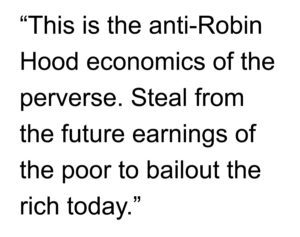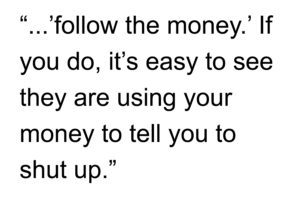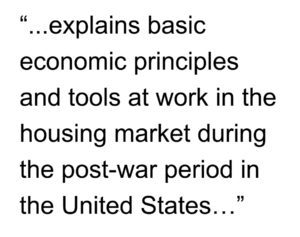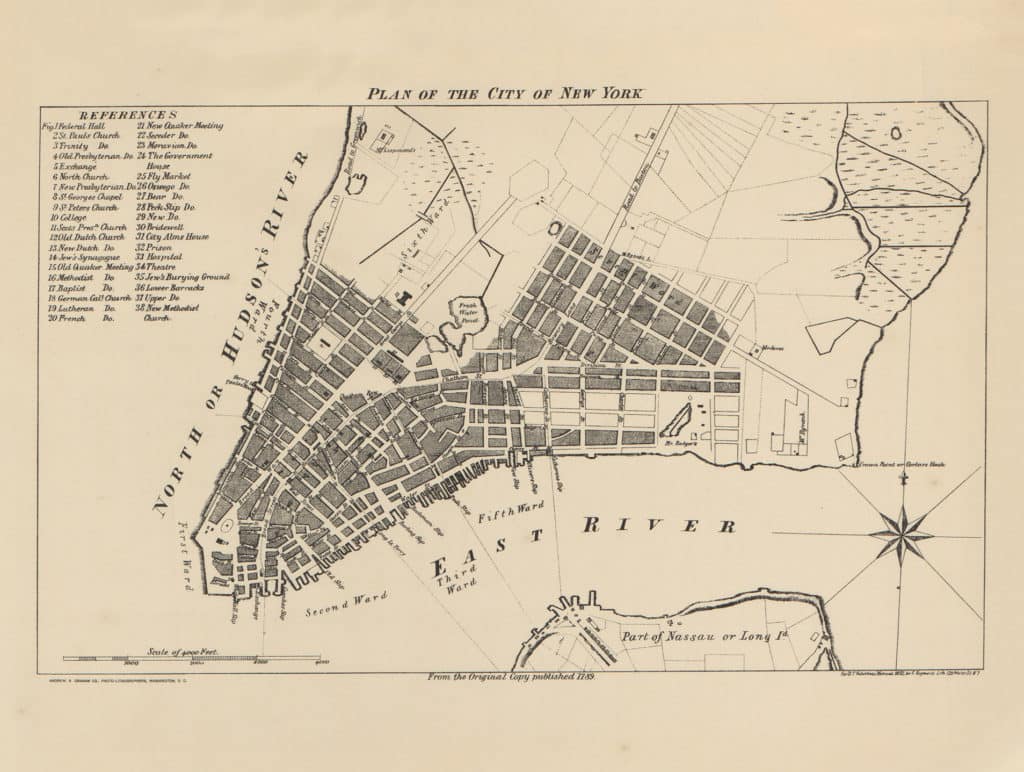The Editorial leftist Folio Weekly Was Too Afraid to Publish
Corporate Welfare Queens Bankroll Opposition to Amendment 4
by Mark David Major, AICP, The Outlaw Urbanist contributor
The opposition to Amendment 4 is using taxpayer money to try and stop you from having a voice in the future of where you live, work and play: our neighborhoods and towns. They are trying to silence your voice about the future of Florida’s growth and development. Home builders and their vassals are principally responsible for bankrolling millions of dollars in opposition to Amendment 4. The only argument they have is fear because no one (not even the home builders) has the political courage to defend the morally corrupt and intellectually bankrupt growth management process in the State of Florida over the last 30+ years. And the home builders are trying to scare you using your own money.
Do you want to talk about the audacity of audacity? Let’s follow the money.
 At the beginning of this year, the Democratic Congress passed and President Obama signed into law an extension of unemployment benefits compensation. So far, so good: right? But the special interests in Washington DC successfully lobbied to insert something more into the bill: a tax loophole for the home building industry. The national home builders were able to claim losses over the last 2 years against federal taxes on their corporate profits during the previous 5 years. Basically, this means the federal government is using deficit spending (by borrowing mainly from China, Japan and the United Kingdom) to refund corporate taxes on national home builders’ profits during the boom years to compensate for their losses during the Great Recession. Of course, it will be left to this generation and future generations of unborn Americans to pay this debt.
At the beginning of this year, the Democratic Congress passed and President Obama signed into law an extension of unemployment benefits compensation. So far, so good: right? But the special interests in Washington DC successfully lobbied to insert something more into the bill: a tax loophole for the home building industry. The national home builders were able to claim losses over the last 2 years against federal taxes on their corporate profits during the previous 5 years. Basically, this means the federal government is using deficit spending (by borrowing mainly from China, Japan and the United Kingdom) to refund corporate taxes on national home builders’ profits during the boom years to compensate for their losses during the Great Recession. Of course, it will be left to this generation and future generations of unborn Americans to pay this debt.
Let’s be clear. This is a “backdoor” government bailout: nothing more, nothing less.
But wait, there’s more. After receiving their bailout, the national home builders report the tax refund as profit to Wall Street, thereby maintaining the value of their shares. Most home builder shares lost more than 80% of their value during the financial crisis, broadly dropping from $35-45 a share to around $10 or less a share. Even with this backdoor government bailout, home builder share prices had only remained stable more or less near their historic lows. So, not only is the federal government propping up the obsolete business models of the home building industry that planted the seeds of this Great Recession in the first place (especially in Florida, California and Nevada) and not only is it also the means to artificially inflate home builder share value on stock market to create another “bubble” but it isn’t even working all that well. To any common sense American, this is a waste of money on an almost unimaginable scale.
Oh, and the unemployed? At the same time the home builders are receiving billions of dollars in backdoor government bailouts, the federal government taxes as income the unemployment compensation payments for the unemployed. This is the anti-Robin Hood economics of the perverse. Steal from the future earnings of the poor to bailout the rich today.  It is a house of cards waiting to fall all over again. And, once again, it will be left to the taxpayers to cover the bills.
It is a house of cards waiting to fall all over again. And, once again, it will be left to the taxpayers to cover the bills.
In the early 90s, Welfare Reform was a major legislative achievement of President Clinton and Newt Gingrich’s Republican Congress. It rolled back one of the worst abuses of Johnson’s Great Society programs by getting people off the welfare rolls and back into the workplace. At its core was the idea there is dignity in being able to work and stand on your own without government assistance. Now, we have the new phenomenon of the Corporate Welfare Queens. The banks, auto industry and, now, the home builders are just some who have been caught red-handed sucking at the teat of the federal government. How are these Corporate Welfare Queens any different from the welfare queens President Reagan used to describe as both an abuser and victim of the system? Well, for one thing, we are talking about corporations that are too stubborn, too beholden to their quarterly profit reports to Wall Street, who possess obsolete business models they are too cowardly or dense to change in order to address the new economic realities. They would rather stick their fingers in their ears and hum really loud (and insert their heads with the fingers plugging their ears into the sand, for good measure) rather than adapt their business models and methods. Corporations like this should be allowed to perish in a capitalist society. The innovators will survive and thrive. The dinosaurs will finally become extinct, as they should. Instead, the federal government is using corporate welfare to pervert the marketplace and these obsolete industries are as happy as pigs at the trough. Today, what we clearly need is Corporate Welfare Reform.
So what does this have to do with Amendment 4? The home building industry has bankrolled 40% of the funds raised to oppose Amendment 4. The rest of the funds raised to oppose Amendment 4 largely come from businesses/organizations providing support services – and receiving income – from the home builders. Amendment 4 is a ballot initiative designed to give voters a say on major changes to their community’s future land use map; specifically, how our neighborhoods and towns in Florida will grow in the future. They want to deny you a voice in your future.
Many voters are old enough to remember the Watergate adage, “follow the money.” If you do, it’s easy to see they are using your money to tell you to shut up. But this is our Florida.  They may have more money (even if a part of it was stolen from you) but there are more of us. Nothing can stop the power of The People when they decide to act (see the Revolutionary War against King George and the British Empire for a relevant example). Let your voices be heard loud and clear this November 2nd. Vote YES on Amendment 4.
They may have more money (even if a part of it was stolen from you) but there are more of us. Nothing can stop the power of The People when they decide to act (see the Revolutionary War against King George and the British Empire for a relevant example). Let your voices be heard loud and clear this November 2nd. Vote YES on Amendment 4.
Tea, anyone?
Mark David Major, AICP is a certified planner of the American Institute of Certified Planners, a former planner for a national home builder and former Chair of the First Coast Section, Florida Chapter of the American Planning Association from 2005-2008.
This editorial was originally written October 26, 2010 and submitted to Folio Weekly for their back page editorial. It was never published and Amendment 4 was defeated by 67% of the vote in the November 2010 election. The scare tactics employed by the home builders, government officials, and real estate and planning professionals to defeat Amendment 4 was instrumental in driving up vote turnout and electing the current unpopular Republican Governor of Florida, Rick Scott. Today, the Florida real estate market remains vastly overbuilt with inventory on life-support. You reap what you sow. Don’t believe the bizarre rants and maniacal claims of real estate agents about a “hot” real estate market. They are lying to you.
 self-deluding assumptions underlying the housing and real estate market, which collectively sparked the Great Recession from 2008 until ‘to be determined’. The course is tailored for architecture, urban design and planning professionals, students, and others engaged in creating built environments to better understand the impact of these often unseen, poorly understood forces at work on their livelihood and the future of our cities (2.0 hour course).
self-deluding assumptions underlying the housing and real estate market, which collectively sparked the Great Recession from 2008 until ‘to be determined’. The course is tailored for architecture, urban design and planning professionals, students, and others engaged in creating built environments to better understand the impact of these often unseen, poorly understood forces at work on their livelihood and the future of our cities (2.0 hour course).






 At the beginning of this year, the Democratic Congress passed and President Obama signed into law an extension of unemployment benefits compensation. So far, so good: right? But the special interests in Washington DC successfully lobbied to insert something more into the bill: a tax loophole for the home building industry. The national home builders were able to claim losses over the last 2 years against federal taxes on their corporate profits during the previous 5 years. Basically, this means the federal government is using deficit spending (by borrowing mainly from China, Japan and the United Kingdom) to refund corporate taxes on national home builders’ profits during the boom years to compensate for their losses during the Great Recession. Of course, it will be left to this generation and future generations of unborn Americans to pay this debt.
At the beginning of this year, the Democratic Congress passed and President Obama signed into law an extension of unemployment benefits compensation. So far, so good: right? But the special interests in Washington DC successfully lobbied to insert something more into the bill: a tax loophole for the home building industry. The national home builders were able to claim losses over the last 2 years against federal taxes on their corporate profits during the previous 5 years. Basically, this means the federal government is using deficit spending (by borrowing mainly from China, Japan and the United Kingdom) to refund corporate taxes on national home builders’ profits during the boom years to compensate for their losses during the Great Recession. Of course, it will be left to this generation and future generations of unborn Americans to pay this debt. It is a house of cards waiting to fall all over again. And, once again, it will be left to the taxpayers to cover the bills.
It is a house of cards waiting to fall all over again. And, once again, it will be left to the taxpayers to cover the bills. They may have more money (even if a part of it was stolen from you) but there are more of us. Nothing can stop the power of The People when they decide to act (see the Revolutionary War against King George and the British Empire for a relevant example). Let your voices be heard loud and clear this November 2nd. Vote YES on Amendment 4.
They may have more money (even if a part of it was stolen from you) but there are more of us. Nothing can stop the power of The People when they decide to act (see the Revolutionary War against King George and the British Empire for a relevant example). Let your voices be heard loud and clear this November 2nd. Vote YES on Amendment 4.